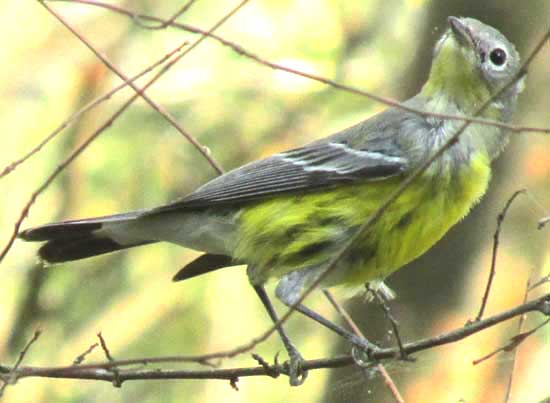Excerpts from Jim Conrad's
Naturalist Newsletter
from the March 12, 2017 Newsletter issued from Rancho Regenesis in the woods ±4kms west of Ek Balam Ruins; elevation ~40m (~130 ft), N20.876°, W88.170°; north-central Yucatán, MÉXICO These days as the dry season grows ever hotter, ever drier, most deciduous trees are losing their leaves so as to save water that otherwise the leaves would transpire. The forest is more open now, you can see through it, and birds are much more noticeable than just a month ago. Also, maybe birds are more active, diligently foraging migrants storing up fat for their spring trip north, but even permanent residents having to forage more vigorously as food grows scarcer. At dawn during my campfire breakfasts normally several species show up working through dense growth beside the hut. White-eyed Vireos, Clay-colored Thrushes, Melodious Blackbirds and Blue Buntings are among the most frequent visitors, while White-tiped Doves call Wh' whoo-ooo, wh' whoo-ooo from the forest floor just beyond, and a Pheasant Cuckoo calling with an echoic whee whee wheerr-rr with the last note quavered. Above you can see a winter-visiting woodwarbler that this week passed by the hut. I had to study my field guide awhile before feeling confident that this was a Magnolia Warbler, DENDROICA MAGNOLIA. Up north, Magnolia Warblers normally are easy to recognize because their brightly yellow underparts are boldly marked with black streaks running lengthwise, their wings bear substantial white wingpatches, their rumps are yellow, and they frequently flash the conspicuous white patches atop their tail feathers. The bird in the picture, however, with its overwintering immature or basic plumage, was furtive, not eager to attract any attention at all, so it didn't flaunt any of its memorable field marks. Still, surveying all woodwarblers possibly found here, it turned out that if a warbler displays white wingbars -- even modest ones like ours shows -- has a yellow throat and underparts, a belly showing at least hints of dark, longitudinal markings, and around the eye there's a definite white ring, it's a Magnolia Warbler and nothing else. Up North, Magnolia Warblers nest in moist hemlock and spruce forests of Canada and New England in the US, and at higher elevations in the Appalachian Mountains. They migrate through most of eastern North America, and winter from southern Mexico and the Caribbean south to Panama. Down here we don't have hemlocks and spruces, but the birds seem to content with our humid to semiarid forests and edges, secondary growth and plantations.
MAGNOLIA WARBLER AT BREAKFAST
